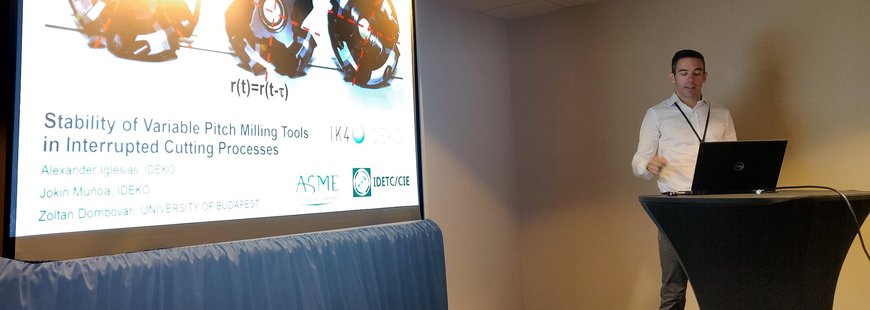New systems for chatter suppression in industrial manufacturing processes
Improving the dynamic stability of machines and increasing the efficiency of production processes remains one of the main challenges for manufacturers of industrial machinery and equipment.

- IK4-IDEKO has presented the conclusions of a study to reduce dynamic instability in production processes at the IDETC-CIE conference.
- The main objective of the research is to find solutions to the problems generated by chatter with which it is possible to obtain more precise and long-lasting equipment.
- The international event, held between 18 and 21 August in California, serves as a meeting point to learn about emerging technologies in engineering.
The research centre specialising in Advanced Manufacturing IK4-IDEKO works to find solutions to this problem through different research aimed at cancelling chatter caused during manufacturing processes.
In this context, the entity presented the conclusions of a study to cancel chatter generated during interrupted cutting processes at the event International Design Engineering Technical Conferences & Computers and Information in Engineering Conference (IDETC-CIE), held August 18-21 in Anaheim, California.
"Chatter not only limits productivity, but also leads to severe wear of cutting tools, causes damage to machine components and erodes the quality of manufactured components due to the poor surface finish", explains Alex Iglesias, a researcher in Dynamics and Control at the research centre, who presented the paper.
The research, carried out together with experts Jokin Muñoa and Zoltan Donmvobary, who also work in IDEKO's Dynamics and Control line, offers solutions to eliminate dynamic instability through the development of systems that guarantee more precise and long-lasting equipment.
During the event, Iglesias presented one of the solutions drawn from his study, based on the use of variable pitch tools, an alternative that may be used to stabilise the cutting process.
"Chatter in milling processes is a vibratory phenomenon that can be described by a differential delay equation with time-dependent coefficients. In the case of uniform pitch tools, the above-mentioned equation has a unique delay related to the tooth pitch frequency. However, this delay can be modified using tools with a special geometry, for example, those with variable pitch" Iglesias says.
Even though the cutting stability of variable-pitch tools has been studied extensively in several research papers, until now the characteristics of instability when carrying out interrupted cutting processes with these tools had not been properly analysed.
"In our work we analyse the stability of variable-pitch cutting tools that perform interrupted cutting operations and the specific characteristics of these tools are specified when they are subjected to flip or saddle-node stability losses in interrupted cutting processes. Finally, theoretical stability simulations and experimental trials using variable-pitch milling machines are presented to support these new findings," he concludes.
At the international IDETC-CIE event, organised by the association American Society of Mechanical Engineers (ASME) and which serves as a meeting point for specialists from the world of research and industry, emerging engineering technologies as well as critical elements of design and development that impact products were presented.
www.ideko.com

